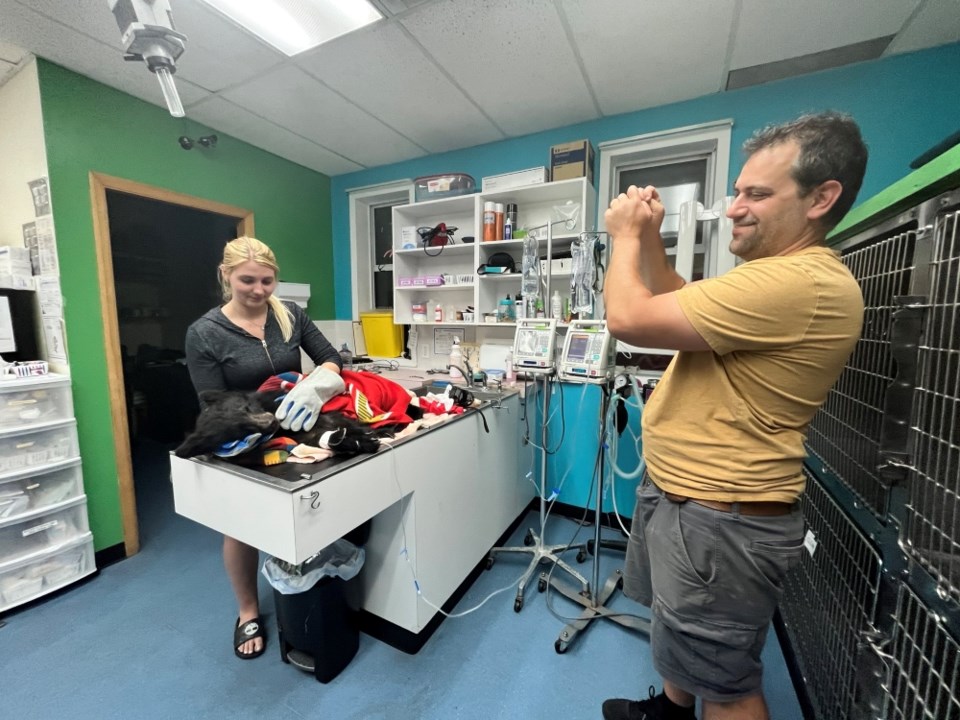As new bears emerge on the Sunshine Coast, one cub has already succumbed to its injuries after being hit by a car, despite an impressive team effort to save its life.
In the evening of May 21, the cub was hit by a vehicle on the highway. Dre Watterworth, who volunteers with Gibsons Wildlife Rehabilitation Centre and has a background as a vet tech assistant, happened to be in the area at the time and rushed over.
While the driver of the van who hit the cub stuck around, he couldn't take the bear in his van. So, Watterworth and her boyfriend put the cub in the back of his pickup truck. Watterworth travelled in the box with the injured cub and a police officer who attended the scene escorted the couple to Gibsons to make sure they weren't pulled over.
"It was a long drive," said Watterworth. "My heart is broken to be honest."
Ameleia Clark, who has worked at the Gibsons Wildlife Rehab Centre for six years, said the cub was unresponsive when he arrived, and had had several seizures on the way. Clark and Irene Davy, the co-founder of the centre, assessed the cub. He was bleeding from his nose. They called nearby veterinarian Dr. Jesse Davicioni of the Gibsons Animal Hospital for help.
They needed to transport the cub to Critter Care in Langley as quickly as possible, but, “Ferries give us a really hard time crunch when it comes to transporting injured animals,” Clark said. They put the bear on fluids, but despite attempting to catch the next ferry, they didn’t make it on board. They moved the cub into Randy’s, a volunteer, vehicle. Instead of waiting at the terminal, the team decided to turn back to monitor the bear and administer more fluids and medication.
After catching a 10:30 p.m. ferry, the cub finally arrived at Critter Care after midnight. He survived the first night but succumbed to his injuries by Tuesday morning
In a Facebook post, the Gibsons Wildlife Rehab Centre shared the bear’s fate: “Sadly this little bear cub didn’t survive his internal injuries after a vehicle strike in the Pender Harbour area,” Irene Davy wrote.
“Although we don’t normally feature animals that died from their injuries, we wish to acknowledge and offer our heartfelt thanks to all those who, instead of enjoying a leisurely evening, put in the time and effort to try to save him. This includes the RCMP, and Tammy and Jeff for watching over him; our volunteers Dre and Linden for transporting him to Gibsons Wildlife; Dr. Jesse from Gibsons Animal Hospital, who with help from our staff member Ameleia … stabilized him until he could be safely transported by Randy on the last ferry to Critter Care in Langley, and to Nathan and the interns patiently waiting at Critter Care to take him in.
“In this world of turmoil, there are still many caring people around who are willing, at a moment's notice, to spend considerable time and effort to rescue injured wildlife. Thank you all!”
Such an extensive team effort is not typical, Clark said. “This was definitely a special occasion. Everybody wanted this little cub to survive. He was given every chance that we could to help him.
“I hope people appreciate the wildlife because if we don’t start treating it better, birds and bears are going to be a myth.”
How to help
The Sunshine Coast Bear Alliance (SCBA) said there are at least six new bear families between Langdale and Pender Harbour this season, with one family frequenting Gibsons’ Gospel Rock area and another passing through Sechelt’s Kinnikinnick trails.
The mother and sibling of the bear who died are still in the area, the SCBA said, and drivers are asked to use caution. Mother and cub bears tend to stay closer to the urban-wildland interface, away from male bears.
Although fall is typically the highest risk time of year for wildlife collisions, the spring and early summer can also be peak times, the SCBA said. Tammy Trefry of Coastal Wildlife Rescue said they’ve been responding to hits on the road non-stop. Her advice is if people see one creature, assume another is following.
“If you see a bear crossing a roadway, there may be cubs dawdling behind a Mum so please make sure the entire family has safely crossed before resuming your drive. This applies to all wildlife families,” the SCBA recommends.
In particular, drivers should be alert at dusk and dawn, around creeks and drainages, and near habitats or water sources.
People using trails, or out with their dogs, should also stay alert to their surroundings and never let their dog approach bears.
Clarke said people coming across injured wildlife should be kind, be smart and not handle the animal too much. Too often, the rehab centre has seen baby animals passed around to children, which is “detrimental to their fighting chances.” Instead, secure the animal if possible, but first call for experienced help from the Gibsons Wildlife Rehab Centre.
The Gibsons Wildlife Resource Centre is still looking for more volunteers to help care for injured and orphaned wildlife. People interested in volunteering can call Clark at 778-891-3642.

